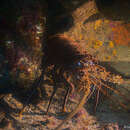mk
имиња во трошки


Die Braune Languste (Panulirus echinatus) ist eine Art aus der Familie der Langusten.
Die maximale Körperlänge dieser Langustenart beträgt 39 Zentimeter. Sie ist im Zentralatlantik rund um die zentralatlantischen Inseln sowie an der Küste von Nordostbrasilien zu finden.
Die Braune Languste zählt unter den Langusten zu den Seichtwasserarten und lebt in einer Meerestiefe von 0 bis maximal 35 Metern. Sie lebt bevorzugt auf Felsböden, ist wie alle Langustenarten nachtaktiv und versteckt sich tagsüber in Felsspalten. Eiertragende Weibchen haben einen Carapax von 5 bis 10 Zentimeter.
Die Braune Languste (Panulirus echinatus) ist eine Art aus der Familie der Langusten.
Die maximale Körperlänge dieser Langustenart beträgt 39 Zentimeter. Sie ist im Zentralatlantik rund um die zentralatlantischen Inseln sowie an der Küste von Nordostbrasilien zu finden.
Die Braune Languste zählt unter den Langusten zu den Seichtwasserarten und lebt in einer Meerestiefe von 0 bis maximal 35 Metern. Sie lebt bevorzugt auf Felsböden, ist wie alle Langustenarten nachtaktiv und versteckt sich tagsüber in Felsspalten. Eiertragende Weibchen haben einen Carapax von 5 bis 10 Zentimeter.
Panulirus echinatus, the brown spiny lobster, is a species of spiny lobster that lives on rocky reefs in the tropical western Atlantic Ocean and central Atlantic Islands.
Like other spiny lobsters, Panulirus echinatus has no pincer-like chelae on its front walking legs. It differs from related species by having just two large spines on the antennular plate, just in front of the carapace, and the exopod of the third feeding appendage is reduced and bears no flagellum. The basic colour is brown with large white rounded spots. The antennules and limbs are brown and have longitudinal white or yellow markings. The average size varies over different parts of its range, with males growing to a carapace length of about 19 cm (7.5 in) and females 15 cm (6 in).[3] Males are in general more numerous, larger and heavier than females but this may be because of behavioural differences, with females feeding less during the breeding season.[4]
Panulirus echinatus is found off the coasts of northern Brazil and on the Atlantic Islands of Cape Verde, Saint Helena, Ascension Island, Tristan da Cunha and the Canary Islands.[1] Its depth range is about 35 m (115 ft) though it is seldom deeper than 25 m (82 ft). It lives on rocks and among boulders, hiding in cracks and fissures during the day.[3]
Panulirus echinatus is a nocturnal generalist feeder and opportunistic browser. Examination of the stomach contents of animals caught on the Saint Peter and Saint Paul Archipelago show that the largest dietary item is fish, although it is not clear whether this is caught by the animal as prey or is the result of scavenging activity. Crustaceans formed part of the diet as did the green alga Caulerpa racemosa which is common in the study area. Another item consumed was calcareous algae scraped off the rock surface and this is likely to be an important source of calcium for the formation of the hard shell. Rock fragments found in the stomach are likely to have been ingested accidentally.[5]
Females carry their egg mass around on their abdomens, under their tails, for several months until the eggs hatch. During this period the females are likely to hide away more in crevices and spend less time feeding. Males do not change their feeding behaviour during the breeding season.[4] Little is known of the larval development of this species but the larvae are planktonic. A late-stage phyllosoma larva taken in mid-ocean has been shown by mitochondrial DNA analysis to belong to this species.[6]
Panulirus echinatus has a wide distribution and seems to be very common within that range. It is harvested in most of the areas in which it is found and in Saint Helena and the Cape Verde Islands is fished commercially. The population trend is unclear but because of the fishing pressure throughout its range, the population is likely to have been reduced over the years. However, because of the high fecundity of the female, this spiny lobster is likely to be resilient and not suffer local extinctions. The International Union for Conservation of Nature has assessed its conservation status as being of "least concern".[1]
Panulirus echinatus, the brown spiny lobster, is a species of spiny lobster that lives on rocky reefs in the tropical western Atlantic Ocean and central Atlantic Islands.
Panulirus echinatus is een tienpotigensoort uit de familie van de Palinuridae.[2] De wetenschappelijke naam van de soort is voor het eerst geldig gepubliceerd in 1869 door Smith.
Bronnen, noten en/of referenties
Panulirus echinatus Smith[2] är en kräftdjursart.
Grundfärgen är brun med vita, runda fläckar. Hanarna blir 19 cm, honorna 15 cm. 39 cm långa exemplar har förekommit.
Carapaxen hos romstinna honor är 5 … 10 cm. Äggen bärs där i flera månader, innan de kläcks. Larverna kallas phyllosoma.
Som alla hummerartter är även denna nattaktiv. På dagen gömmer den sig i skrevor mellan stenarna på bottnen. Saknar klor på de främre benen, som den förflyttar sig med.
I de flesta bestånden finns det fler hanar än honor.
Vistas kring mellersta Atlantens öar och kusten av nordöstra Brasilien.
Håller till på vattendjup från 0 och ner till max 35 m, men oftast inte djupare än 25 m. Helst söker den sig till områden med stenig botten.
IUCN kategoriserar arten globalt som livskraftig.[1]
Inga underarter finns listade i Catalogue of Life.[3]
Panulirus echinatus Smith är en kräftdjursart.
Panulirus echinatus, tôm hùm gai nâu, là một loài tôm hùm gai sinh sống ở các đá ngầm ở tây Đại Tây Dương và các đảo trung Đại Tây Dương nhiệt đới.
Panulirus echinatus, tôm hùm gai nâu, là một loài tôm hùm gai sinh sống ở các đá ngầm ở tây Đại Tây Dương và các đảo trung Đại Tây Dương nhiệt đới.